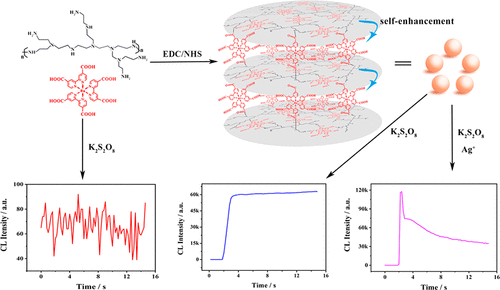当前位置:
X-MOL 学术
›
Anal. Chem.
›
论文详情
Our official English website, www.x-mol.net, welcomes your
feedback! (Note: you will need to create a separate account there.)
Self-Enhanced Chemiluminescence of Tris(bipyridine) Ruthenium(II) Derivative Nanohybrids: Mechanism Insight and Application for Sensitive Silver Ions Detection.
Analytical Chemistry ( IF 6.7 ) Pub Date : 2020-05-07 , DOI: 10.1021/acs.analchem.0c00897 Mengxia Yan 1, 2 , Jing Ye 2 , Qiuju Zhu 2 , Liping Zhu 2 , Ting Xiao 1, 2 , Jianshe Huang 1 , Xiurong Yang 1, 2
Analytical Chemistry ( IF 6.7 ) Pub Date : 2020-05-07 , DOI: 10.1021/acs.analchem.0c00897 Mengxia Yan 1, 2 , Jing Ye 2 , Qiuju Zhu 2 , Liping Zhu 2 , Ting Xiao 1, 2 , Jianshe Huang 1 , Xiurong Yang 1, 2
Affiliation

|
In recent years, self-enhanced tris(bipyridine) ruthenium(II)-based luminescence systems have achieved great development in electrochemiluminescence (ECL) but are seldom mentioned in chemiluminescence (CL). Herein, a self-enhanced CL luminophore with excellent CL behavior was synthesized by covalently cross-linking tris(4,4'-dicarboxylic acid-2,2'-bipyridyl) ruthenium(II) dichloride ([Ru(dcbpy)3]Cl2) with branched polyethylenimine (BPEI) in one molecule (BPEI-Ru(II)), which then self-assembled into nanoparticles (BRuNPs). The nanoparticles exhibited stable and strong CL emission with potassium persulfate (K2S2O8) as the oxidant. After the redox reaction between K2S2O8 and BRuNPs, and the subsequent intramolecular electron-transfer reaction, excited state luminophores were generated to emit light. This self-enhanced CL system shortened the electron transfer distance and reduced energy loss, thus improving the luminous efficiency. In addition, the CL lifetime of BRuNPs/K2S2O8 was longer than classical luminophores such as N-(4-aminobutyl)-N-ethylisoluminol (ABEI), indicating the potential application of this system in CL imaging. Surprisingly, Ag+ was found to greatly improve the CL efficiency of BRuNPs/K2S2O8 by catalyzing the decomposition of K2S2O8 to generate SO4•-. On the basis of the enhancement effect of Ag+, a simple and rapid CL method was proposed for Ag+ detection. The chemosensor showed a wide linear range from 25 to 3000 nM and low detection limit of 9.03 nM, as well as good stability and excellent selectivity. More importantly, this result indicated that Ag+ can be used as a coreaction accelerator to develop a ternary self-enhanced CL system, BRuNPs/K2S2O8/Ag+.
中文翻译:

三(联吡啶)钌(II)衍生物纳米杂化物的自增强化学发光:机理见解和灵敏银离子检测的应用。
近年来,基于自增强三(联吡啶)钌(II)的发光系统在电化学发光(ECL)中取得了长足的发展,但在化学发光(CL)中却很少提及。在此,通过共价交联三氯化三(4,4'-二羧酸-2,2'-联吡啶基)钌(II)([Ru(dcbpy)3] Cl2 )与一个分子中的支化聚乙烯亚胺(BPEI)(BPEI-Ru(II)),然后自组装成纳米颗粒(BRuNP)。以过硫酸钾(K2S2O8)为氧化剂,纳米颗粒表现出稳定而强的CL发射。在K2S2O8与BRuNP之间的氧化还原反应以及随后的分子内电子转移反应之后,产生了激发态发光体以发光。这种自增强的CL系统缩短了电子传输距离并减少了能量损失,从而提高了发光效率。此外,BRuNPs / K2S2O8的CL寿命比经典的发光体(例如N-(4-氨基丁基)-N-乙基异鲁米诺(ABEI))更长,表明该系统在CL成像中的潜在应用。出乎意料的是,发现Ag +通过催化K2S2O8分解生成SO4•-极大地提高了BRuNPs / K2S2O8的CL效率。基于Ag +的增强作用,提出了一种简便快速的CL +检测方法。化学传感器显示出从25到3000 nM的宽线性范围和9.03 nM的低检测限,以及良好的稳定性和出色的选择性。更重要的是,
更新日期:2020-04-27
中文翻译:

三(联吡啶)钌(II)衍生物纳米杂化物的自增强化学发光:机理见解和灵敏银离子检测的应用。
近年来,基于自增强三(联吡啶)钌(II)的发光系统在电化学发光(ECL)中取得了长足的发展,但在化学发光(CL)中却很少提及。在此,通过共价交联三氯化三(4,4'-二羧酸-2,2'-联吡啶基)钌(II)([Ru(dcbpy)3] Cl2 )与一个分子中的支化聚乙烯亚胺(BPEI)(BPEI-Ru(II)),然后自组装成纳米颗粒(BRuNP)。以过硫酸钾(K2S2O8)为氧化剂,纳米颗粒表现出稳定而强的CL发射。在K2S2O8与BRuNP之间的氧化还原反应以及随后的分子内电子转移反应之后,产生了激发态发光体以发光。这种自增强的CL系统缩短了电子传输距离并减少了能量损失,从而提高了发光效率。此外,BRuNPs / K2S2O8的CL寿命比经典的发光体(例如N-(4-氨基丁基)-N-乙基异鲁米诺(ABEI))更长,表明该系统在CL成像中的潜在应用。出乎意料的是,发现Ag +通过催化K2S2O8分解生成SO4•-极大地提高了BRuNPs / K2S2O8的CL效率。基于Ag +的增强作用,提出了一种简便快速的CL +检测方法。化学传感器显示出从25到3000 nM的宽线性范围和9.03 nM的低检测限,以及良好的稳定性和出色的选择性。更重要的是,

































 京公网安备 11010802027423号
京公网安备 11010802027423号